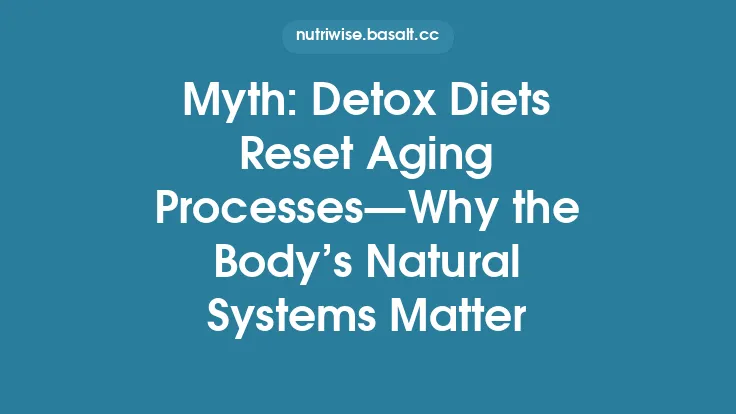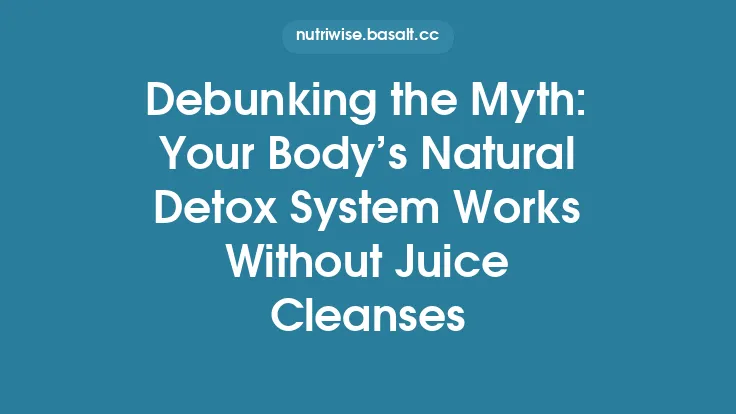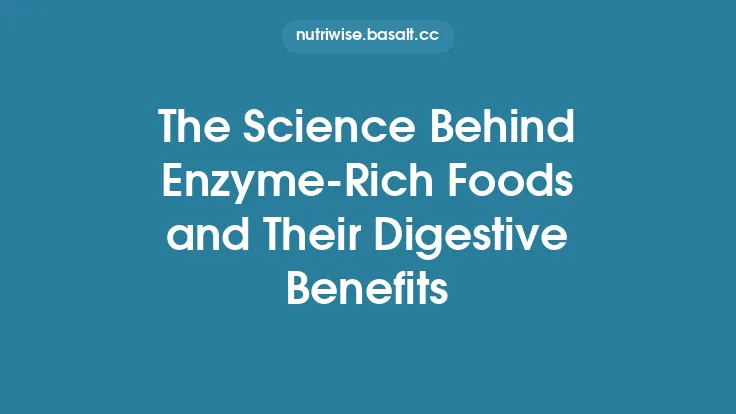The human body is equipped with a sophisticated network of physiological processes that continuously remove metabolic by‑products, dietary residues, and environmental chemicals. While the liver, kidneys, lungs, and skin are often highlighted as the primary “detox” organs, the gastrointestinal tract and the antioxidant defense system play equally vital, though sometimes underappreciated, roles. Two dietary components—dietary fiber and antioxidants—are especially powerful in supporting these innate cleansing pathways. By understanding how they work, you can make evidence‑based choices that reinforce the body’s natural ability to stay clean, balanced, and resilient.
Understanding Fiber: Types and Functions
Fiber is the indigestible portion of plant foods that reaches the colon largely intact. It is broadly classified into two categories:
| Type | Solubility | Fermentability | Typical Sources |
|---|---|---|---|
| Soluble fiber | Dissolves in water, forming a viscous gel | Highly fermentable by colonic bacteria | Oats, barley, legumes, apples, citrus pectin |
| Insoluble fiber | Does not dissolve; adds bulk | Poorly fermentable | Wheat bran, whole‑grain wheat, nuts, seeds, vegetable skins |
Both types contribute to health, but they do so via distinct mechanisms. Soluble fiber’s gel‑forming capacity slows gastric emptying, moderates post‑prandial glucose spikes, and binds bile acids. Insoluble fiber, by increasing stool bulk, accelerates transit time and reduces the contact period between potential irritants and the intestinal mucosa.
How Fiber Facilitates Waste Elimination
- Binding of Bile Acids and Sterols
Soluble fibers such as β‑glucan and pectin can sequester bile acids in the lumen. When bile acids are excreted rather than reabsorbed, the liver must synthesize new bile from cholesterol, thereby lowering circulating LDL cholesterol. This process also removes cholesterol‑derived metabolites that could otherwise accumulate.
- Adsorption of Potentially Harmful Compounds
Certain fibers possess a high surface area and can adsorb dietary toxins, heavy metals, and xenobiotics. For example, the mucilage in psyllium has been shown in vitro to bind aflatoxin B1, reducing its bioavailability.
- Modulation of Transit Time
By increasing stool bulk, insoluble fiber reduces the residence time of fecal matter. Faster transit limits the opportunity for bacterial deconjugation of bile acids and the formation of secondary metabolites that may be irritating or pro‑inflammatory.
- Fermentation to Short‑Chain Fatty Acids (SCFAs)
Fermentable fibers are metabolized by colonic microbiota into SCFAs—primarily acetate, propionate, and butyrate. Butyrate serves as the primary energy source for colonocytes, promotes tight‑junction integrity, and exerts anti‑inflammatory effects. SCFAs also stimulate the release of peptide YY and glucagon‑like peptide‑1, hormones that influence appetite and glucose homeostasis, indirectly supporting metabolic “cleanliness.”
The Role of Soluble vs. Insoluble Fiber in Gut Health
- Soluble Fiber
- Forms a viscous matrix that can trap lipids and sugars, slowing their absorption.
- Provides a substrate for beneficial bacteria (e.g., *Bifidobacterium and Lactobacillus*), fostering a microbiome composition associated with reduced endotoxemia.
- Enhances mucosal barrier function through SCFA production.
- Insoluble Fiber
- Increases fecal bulk, stimulating peristalsis.
- Reduces the risk of diverticular disease by preventing high intraluminal pressures.
- Helps maintain regular bowel movements, a cornerstone of effective waste removal.
A balanced intake of both types—approximately 25 g of fiber per day for women and 38 g for men, with a 1:1 ratio of soluble to insoluble—optimizes these complementary benefits.
Antioxidants: What They Are and Why They Matter
Antioxidants are molecules capable of neutralizing reactive oxygen species (ROS) and reactive nitrogen species (RNS), thereby preventing oxidative damage to lipids, proteins, and nucleic acids. They fall into two broad categories:
| Category | Representative Compounds | Primary Food Sources |
|---|---|---|
| Enzymatic antioxidants | Superoxide dismutase (SOD), catalase, glutathione peroxidase | Endogenously synthesized; activity can be up‑regulated by nutrients (e.g., selenium for GPx) |
| Non‑enzymatic antioxidants | Vitamin C, vitamin E (α‑tocopherol), carotenoids (β‑carotene, lycopene), polyphenols (flavonoids, phenolic acids) | Citrus fruits, nuts, seeds, colorful vegetables, berries, tea, cocoa |
While the body produces its own antioxidant enzymes, dietary antioxidants supplement these defenses, especially during periods of increased oxidative load (e.g., intense exercise, exposure to pollutants, or high‑fat meals).
Mechanisms of Antioxidant Action in the Body
- Direct Scavenging of Free Radicals
Molecules like vitamin C donate electrons to neutralize superoxide, hydroxyl, and peroxyl radicals, converting them into less reactive species.
- Regeneration of Other Antioxidants
Vitamin C can regenerate oxidized vitamin E, creating a synergistic antioxidant network that protects both aqueous and lipid environments.
- Metal Chelation
Polyphenols such as quercetin bind transition metals (iron, copper), limiting their participation in Fenton reactions that generate highly reactive hydroxyl radicals.
- Modulation of Gene Expression
Certain phytochemicals activate the nuclear factor erythroid 2‑related factor 2 (Nrf2) pathway, up‑regulating the expression of endogenous antioxidant enzymes (e.g., SOD, glutathione‑S‑transferase). This adaptive response enhances the body’s capacity to detoxify electrophilic compounds.
- Anti‑Inflammatory Signaling
By reducing oxidative stress, antioxidants indirectly dampen NF‑κB‑mediated inflammatory cascades, which otherwise can impair barrier function and promote the formation of harmful metabolites.
Synergy Between Fiber and Antioxidants
The interaction between fiber and antioxidants is more than additive; it creates a cooperative environment that amplifies detoxification:
- Co‑delivery to the Colon
Many antioxidant‑rich foods (berries, apples, legumes) are also high in fiber. The fiber matrix slows gastric emptying, allowing antioxidants more time to be absorbed in the small intestine, while the remaining polyphenols reach the colon where they are metabolized by microbiota into bioactive phenolic acids.
- Microbial Metabolism Enhances Antioxidant Activity
Gut bacteria convert complex polyphenols into smaller metabolites (e.g., urolithins from ellagitannins) that possess superior bioavailability and anti‑inflammatory properties. A fiber‑rich environment supports a diverse microbiome capable of these transformations.
- SCFA‑Mediated Antioxidant Gene Expression
Butyrate, a product of fiber fermentation, can activate Nrf2, thereby boosting the expression of endogenous antioxidant enzymes. This creates a feedback loop where fiber indirectly strengthens antioxidant defenses.
- Reduced Oxidative Load via Improved Bile Acid Excretion
By binding bile acids, soluble fiber reduces the enterohepatic recirculation of potentially oxidized cholesterol metabolites, decreasing systemic oxidative stress.
Practical Ways to Incorporate Fiber and Antioxidants into Your Diet
| Strategy | Example Foods | Tips for Maximizing Benefit |
|---|---|---|
| Start meals with a fiber‑rich salad | Mixed greens, carrots, bell peppers, chickpeas | Dress with lemon juice (vitamin C) to enhance iron absorption from plant sources |
| Swap refined grains for whole grains | Oats, quinoa, brown rice, whole‑wheat pasta | Soak or sprout grains to reduce phytate content, improving mineral bioavailability |
| Add legumes to soups and stews | Lentils, black beans, split peas | Combine with vitamin C‑rich vegetables to aid non‑heme iron absorption |
| Snack on fruit with edible skins | Apples, pears, berries | The skin contains both soluble fiber (pectin) and concentrated polyphenols |
| Include nuts and seeds | Almonds, walnuts, chia, flaxseed | Ground flaxseed releases lignans and soluble fiber; store nuts in the fridge to prevent oxidation |
| Use herbs and spices liberally | Turmeric, cinnamon, rosemary, oregano | Many spices are dense in polyphenols; pair with a small amount of healthy fat (olive oil) to improve absorption of fat‑soluble antioxidants |
| Choose colorful vegetables | Sweet potatoes, beets, red cabbage, kale | The pigments (carotenoids, anthocyanins) are potent antioxidants; cooking with a bit of oil enhances bioavailability |
| Drink tea or coffee in moderation | Green tea, black tea, coffee | Rich in catechins and chlorogenic acid; avoid adding excessive sugar which can counteract benefits |
Aim for at least 5 servings of fruits and vegetables per day, with a focus on variety to capture a broad spectrum of fiber types and antioxidant compounds.
Potential Pitfalls and Considerations
- Excessive Fiber Intake
Consuming >50 g of fiber daily can cause bloating, flatulence, and interfere with the absorption of minerals such as calcium, magnesium, and zinc. Gradually increase intake and ensure adequate fluid consumption.
- Heat‑Sensitive Antioxidants
Vitamin C and some polyphenols degrade with prolonged high‑heat cooking. Lightly steaming or consuming raw when possible preserves their activity.
- Interaction with Medications
High fiber can affect the absorption of certain drugs (e.g., thyroid hormone replacement, some antibiotics). Space medication intake and high‑fiber meals by at least 2 hours.
- Individual Tolerance
People with irritable bowel syndrome (IBS) may be sensitive to fermentable fibers (FODMAPs). Tailor fiber sources to personal tolerance, emphasizing low‑FODMAP options like oats, chia seeds, and firm‑cooked carrots.
- Quality of Sources
Processed “fiber supplements” may lack the synergistic phytochemicals present in whole foods. Whole‑food sources provide the full matrix of fiber, antioxidants, and micronutrients.
Conclusion: Harnessing Natural Support for Your Body’s Cleansing Systems
Fiber and antioxidants are not exotic “detox” ingredients; they are fundamental components of a diet that aligns with the body’s evolutionary design. By supplying bulk, binding capacity, and fermentable substrates, fiber streamlines the physical removal of waste and modulates the gut microbiome in ways that reduce the generation of harmful metabolites. Antioxidants, meanwhile, safeguard cellular structures from oxidative damage, support the expression of endogenous detoxifying enzymes, and work hand‑in‑hand with fiber‑derived short‑chain fatty acids to reinforce the body’s internal housekeeping.
Incorporating a diverse array of fiber‑rich plant foods and antioxidant‑dense fruits, vegetables, nuts, seeds, and spices creates a resilient, self‑sustaining system that continuously cleanses, repairs, and protects. Rather than chasing quick‑fix “detox” trends, focusing on these evergreen nutritional pillars offers a scientifically grounded, sustainable path to optimal health and metabolic balance.





